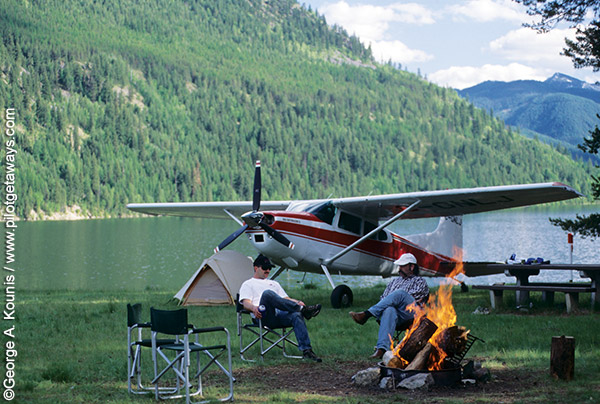You are hereBackcountry Etiquette & Safety - Part II
Backcountry Etiquette & Safety - Part II
Don't Ruin it for Other Folks
by Crista V. Worthy

In Part I, we discussed how to choose a backcountry destination [see the May/June 2012 issue]. We presented a number of resources for finding accurate and timely information about different airstrips, and how to choose one commensurate with your flying skills and equipment. You can find out whether the strip is open, in good condition, and from which directions you can approach and depart. And you can choose an airstrip in an environment appropriate for your planned activities, whether they are to land solo for quiet camping and hiking, or whether you plan a flight with multiple aircraft and group activities.
Once you select a destination, as with any flight, check weather and NOTAMs before departure. Idaho Aviation Association (IAA) District 3 Director Wayne Thiel says experienced Idaho pilots check winds aloft at 9,000 feet MSL; if they're above 20 knots, they'll usually stay home. Big bumps over the mountains and tricky canyon drafts can be dangerous and take the fun out what should be an enjoyable flight. Mountain obscuration is an obvious no-go. NOTAMs can warn of field closures or TFRs to keep you away from smoke and fire-fighting aircraft from forest fires.
If you don't file an FAA flight plan, give someone at home your itinerary so a search can be commenced if you don't return on time. En route, monitor 122.9 MHz and make occasional position reports. Avoid unnecessary chit-chat on this universal frequency. The IAA recommends 122.75 MHz for other conversations; some pilots use “fingers” 123.45 MHz. Cross ridges at a 45-degree angle in case you need to turn back. Fly the right side of canyons when practical to help avoid mid-airs. If downdrafts prevent this, maybe it's too windy for a safe landing. If you land into a stiff headwind on a one-way airstrip, the tailwind on departure may be unsafe until early the next morning when winds are usually calm. Especially in summer, this is the typical rhythm of a backcountry outing: you arrive in the morning, enjoy outdoor activities on the ground for a day or two, and depart again in the morning. If you can't stay overnight, it may be safer to find an airstrip where you can take off in either direction.
The Montana Pilots' Association's Code of Ethics reminds pilots to always keep their aircraft's noise signature to a minimum. Maintain at least 2,000 feet AGL for safety and to limit noise over sensitive areas. Overfly the strip to check for winds and obstructions, but avoid unnecessarily “buzzing the field,” or you might face an unhappy reception from others after you land. It is also not appropriate to practice touch-and-goes or multiple landings in the backcountry; it causes too much noise and wear and tear on the strips. Pilots with constant-speed propeller aircraft can use lower RPM settings to reduce noise; try to avoid low, power-on approaches. Judicious use of power while taxiing is vital for many reasons. You don't want to fling rocks into your prop. Prop blast increases erosion on the strips and they are not easily repaired. It's also rude to others. One pilot, camped beneath his wing, had several folding chairs blasted into the side of his aircraft. A taxiing pilot blew a tent away at the Cavanaugh Bay airstrip—fortunately his own. That airstrip, incidentally, was temporarily closed because someone created deep ruts by landing when it was too wet.
Many backcountry airstrips lack tiedowns, so bring your own. The IAA's Vice President of Backcountry Issues, Jack Kotaki, says, “Bring chocks too; if you use rocks, move them away from the parking area before departure so someone else doesn't run over them. An area that is clear now may be overgrown later and they'll be invisible. A box of trash bags, rolls of toilet paper, and coffee can lids should be mainstays in the baggage compartment. The trash bag is not just for your own trash, but for that left by others less considerate. If the strip has an outhouse, check the coffee can, leave a fresh roll, and if the lid is cracked, replace it.” Other recommended supplies are duct tape, bug spray or nets, extra food and water, first aid kit, warm clothes, tent and sleeping bags or blankets, a personal locator beacon or tracking device, small tool kit, axe, small shovel, tire-repair kit and pump, Leatherman or Swiss Army Knife, engine oil, brake fluid, and paper towels.
It's understood that pilots will depart early for cool, calm air, often right at dawn. Air campers may not expect to sleep in, but an endless, high-power runup is impolite. In cold weather (though not in wilderness areas) Todd Peterson of Peterson Performance Plus uses a quiet Honda EU-1000 generator with a Reiff pre-heater on the cylinders and oil sump. One hour later, in 17-degree weather, the cylinder temps are in the mid-40s and he's good to go without a long engine warm-up, www.reiffpreheat.com.
Check density altitude and your POH before departure; the soft surface will increase your ground roll distance. Uphill or downwind departures are best avoided. If you must choose between the two, CFII and IAA President Jim Davies' own rule of thumb is to depart downhill and downwind, unless the tailwind is over 15 knots.
Many pilots find backcountry aviation highly rewarding, and so can you. Then share your good fortune and bring someone along who might otherwise not be able to visit these beautiful places. Backcountry and mountain flying take specialized skills. If you're new to backcountry flying, consider instruction from Idaho's McCall Mountain/Canyon Flying Seminars, 208-634-1344, www.mountaincanyonflying.com, or Middle Fork Aviation, 208-879-5728 or 888-283-7258, www.middleforkair.com. You'll learn the piloting skills and etiquette required to successfully explore the backcountry.

